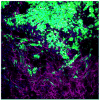Gene therapy for brain cancer: combination therapies provide enhanced efficacy and safety
- PMID: 19860655
- PMCID: PMC2864138
- DOI: 10.2174/156652309789753301
Gene therapy for brain cancer: combination therapies provide enhanced efficacy and safety
Abstract
Glioblastoma multiforme (GBM) is the most common primary brain cancer in adults. Despite significant advances in treatment and intensive research, the prognosis for patients with GBM remains poor. Therapeutic challenges for GBM include its invasive nature, the proximity of the tumor to vital brain structures often preventing total resection, and the resistance of recurrent GBM to conventional radiotherapy and chemotherapy. Gene therapy has been proposed as a useful adjuvant for GBM, to be used in conjunction with current treatment. Work from our laboratory has shown that combination of conditional cytotoxic with immunotherapeutic approaches for the treatment of GBM elicits regression of large intracranial tumor masses and anti-tumor immunological memory in syngeneic rodent models of GBM. In this review we examined the currently available animal models for GBM, including rodent transplantable models, endogenous rodent tumor models and spontaneous GBM in dogs. We discuss non-invasive surrogate end points to assess tumor progression and therapeutic efficacy, such as behavioral tests and circulating biomarkers. Growing preclinical and clinical data contradict the old dogma that cytotoxic anti-cancer therapy would lead to an immune-suppression that would impair the ability of the immune system to mount an anti-tumor response. The implications of the findings reviewed indicate that combination of cytotoxic therapy with immunotherapy will lead to synergistic antitumor efficacy with reduced neurotoxicity and supports the clinical implementation of combined cytotoxic-immunotherapeutic strategies for the treatment of patients with GBM.
Figures




References
-
- Chinot OL, Barrie M, Fuentes S, et al. Correlation between O6-methylguanine-DNA methyltransferase and survival in inoperable newly diagnosed glioblastoma patients treated with neoadjuvant temozolomide. J Clin Oncol. 2007;25:1470–5. - PubMed
-
- Sathornsumetee S, Rich JN. Designer therapies for glioblastoma multiforme. Ann N Y Acad Sci. 2008;1142:108–32. - PubMed
-
- Lefranc F, Brotchi J, Kiss R. Possible future issues in the treatment of glioblastomas: special emphasis on cell migration and the resistance of migrating glioblastoma cells to apoptosis. J Clin Oncol. 2005;23:2411–22. - PubMed
-
- Hegi ME, Diserens AC, Godard S, et al. Clinical trial substantiates the predictive value of O-6-methylguanine-DNA methyltransferase promoter methylation in glioblastoma patients treated with temozolomide. Clin Cancer Res. 2004;10:1871–4. - PubMed
-
- Hegi ME, Diserens AC, Gorlia T, et al. MGMT gene silencing and benefit from temozolomide in glioblastoma. N Engl J Med. 2005;352:997–1003. - PubMed
Publication types
MeSH terms
Grants and funding
- 1U01 NS 052465-01/NS/NINDS NIH HHS/United States
- R21 NS047298/NS/NINDS NIH HHS/United States
- R01 NS061107/NS/NINDS NIH HHS/United States
- U54 NS045309/NS/NINDS NIH HHS/United States
- F32 NS058156/NS/NINDS NIH HHS/United States
- 1R21-NS054143.01/NS/NINDS NIH HHS/United States
- 1F32 NS058156-01/NS/NINDS NIH HHS/United States
- R01 NS057711/NS/NINDS NIH HHS/United States
- R21 NS054143/NS/NINDS NIH HHS/United States
- U54 NS045309-01/NS/NINDS NIH HHS/United States
- R01 NS054193/NS/NINDS NIH HHS/United States
- R01 NS044556/NS/NINDS NIH HHS/United States
- 1R01-NS 057711/NS/NINDS NIH HHS/United States
- U01 NS052465/NS/NINDS NIH HHS/United States
- 1R01 NS44556-01/NS/NINDS NIH HHS/United States
- 1 R01 NS 054193.01/NS/NINDS NIH HHS/United States
- 1 R03 TW 006273-01/TW/FIC NIH HHS/United States
- R01 NS 42893.01/NS/NINDS NIH HHS/United States
- R01 NS042893/NS/NINDS NIH HHS/United States
- 1R21 NS047298-01/NS/NINDS NIH HHS/United States
- R03 TW006273/TW/FIC NIH HHS/United States
LinkOut - more resources
Full Text Sources
Medical
